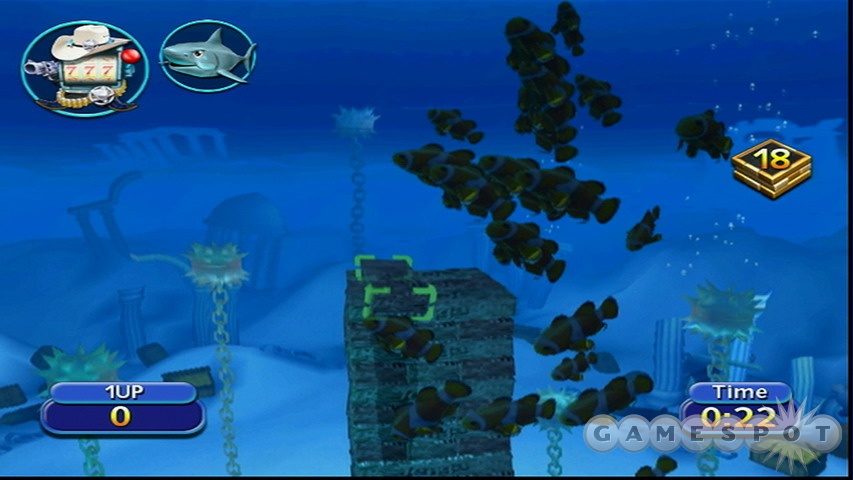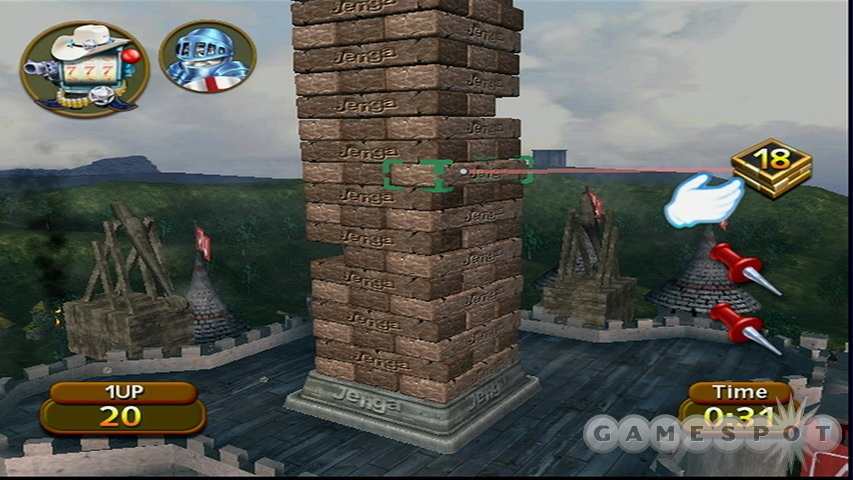The real game of Jenga is a love/hate kind of thing. The actual act of playing this game of block removal and stacking is pretty fun, but goodness knows it's a pain to stack those things up again after the tower comes tumbling down. Jenga World Tour attempts to remedy that admittedly small annoyance by bringing the game of Jenga to the Wii. No cumbersome blocks to stack here; all you have to do is slide out and stack virtual blocks using the Wii Remote. That all sounds good in theory, except that Jenga World Tour also happens to be functionally broken. The game's physics are wonky as all get out, the artificial-intelligence opponents are either overpowered or brain-dead depending on the situation, and many of the goofily themed stages the developers tossed in to give the game a bit of a wacky flavor are so reliant on random chance that they cease to be fun instantly. Couple all of this with the fact that World Tour costs twice as much as the real game of Jenga, and this stacks up as a pretty terrible deal.

As you would with the real game, you play Jenga World Tour by picking out one of the rectangular blocks that sit in the stack, do your best to pull it out without knocking over the entire structure, and set the removed block on the top of the stack. The players take turns until one sends the whole thing toppling over with an ill-conceived block removal, at which point the game ends. On paper, Jenga World Tour seems as if it should have the goods to deliver a solid interpretation of the game. The Wii controls let you pull at the blocks by holding A and moving the Wii Remote, tap them using the B button to push them out ever so slightly and get a better grip on them, and even pin down a couple of other nearby blocks to keep them from jostling around.
That all sounds like a good scheme, except that it doesn't actually work very well. Moving blocks is an extremely hit-or-miss process. When you've got one in your hand, it's impossible to position the block on the top of the stack with any precision. The game's sense of depth perception seems more than a little faulty, and as a result, you'll often overshoot or undershoot your target multiple times before finally getting even close to where you want to go. Of course, all of this assumes you can even get a block out of the stack. There are times when you'll be able to yank a block out with quick and unobstructed ease, and there are times when you'll be stuck spending minutes trying to inch one block out because it's apparently jammed in there super tight. The amount of yanking you have to do when you get pieces stuck like this is just ridiculous, and sometimes leads to you accidentally knocking other blocks around and toppling the whole thing, which you really shouldn't have had to do.
The frustration of being unable to easily remove certain blocks is compounded by the relative ease with which computer opponents can move the same blocks. The AI can take a turn in less than five seconds flat, and often does. The only time it takes longer is at the very end, when playable blocks are at a premium and the whole stack is teetering like crazy, or if you happen to place a block on the top of the stack in such a way that the AI can't figure out how to place its piece correctly. The only time you can do this is if you're placing the second block on the three-block row, so basically every other row. When you do, try to drop the piece a little bit off from wherever the first piece was placed, so that it's not quite in the middle, but not quite all the way to the opposite end, either. The AI becomes lobotomized at this point and fumbles for minutes at a time trying to place its block down in a suitable fashion. We actually had one instance in which the AI got stuck doing this for upwards of 10 minutes. It's initially high comedy to watch this happen, but it's also rather boring by about the fourth or fifth time.
The weirdness of the AI and the sometimes-stubborn block physics really compound into a painfully frustrating experience in the world tour mode, a worldwide jaunt across multiple continents (and, for some reason, multiple time periods) to play Jenga with a bunch of silly themes. Apart from the obvious aesthetic differences of playing Jenga in a pit of molten lava, medieval England, underwater, and in the middle of a dinosaur-filled jungle, there are some gameplay differences to these stages as well. For instance, when you're playing atop a frosty Himalayan mountain, some of the blocks on your stack will actually freeze from turn to turn. Likewise, when you're playing in the lava, the blocks are so hot that you can hold them for only a limited amount of time. (The meter depicting the heat drops every time you set the block down, though, including if you temporarily release it when it's balanced sticking partially out of the stack, so it's not exactly any more of a challenge.)

These wrinkles in the formula aren't much of a big deal, but some of the other factors wreck the game even further by turning the experience into a complete game of chance. In the dinosaur level, the stomping of the nearby dinos will cause your stack to sway a bit; consequently, sometimes you won't even have touched the stack yet on your turn, yet the whole thing will come crashing down just because of some random background element you had no control over. The same goes for the medieval England level, where catapults constantly assail the stack. No single hit actually does much damage, but as the game goes on, they push and push and push until eventually the same sort of random knockdown happens. This level is even worse because all of the catapulting kills the frame rate, which turns the gameplay into a chugging mess. Naturally, a chugging game also slows down your ability to pull out blocks. At some point you'll be sitting there, dumbfounded, watching the game run at around five frames a second while you're endlessly tugging away at some block that just won't budge, and realize right then and there with startling clarity what a colossal mistake this purchase was.
There are other features in Jenga World Tour, but given how utterly inept the core gameplay is, they're basically irrelevant. It doesn't matter if the game has middling visuals and a mostly forgettable soundtrack. You don't need to care about the additional arcade mode (which keeps you playing one long, continuous Jenga game and throws random rule variations at you from row to row). And though playing in multiplayer does indeed alleviate some of the AI troubles, none of this can correct the fact that the act of playing Jenga in Jenga World Tour is no fun at all. The crazy rule variants certainly do their part to stomp out whatever fun this game might have had, but even simply playing a normal, vanilla game of Jenga feels screwed up because of the shoddy controls and physics. An actual game of Jenga, unbroken in every way, costs $15 at most retail outlets. Jenga World Tour, which is thoroughly busted in a number of bizarre ways, costs $30 at all retail outlets. Do the math and stay away.